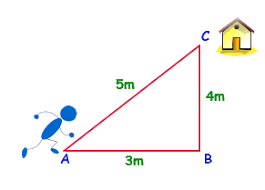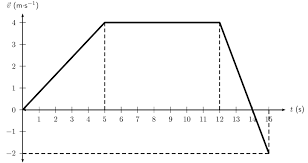Physics is a branch of science. It is further subdivided into many branches. Kinematics, modern and thermal physics, electrostatics, etc. are some of them. These sub-branches deal with different phenomenons. These are usually day-to-day phenomenons. There are different branches for each phenomenon.

Distance vs displacement example
One such branch is kinematics. Kinematics deals with the study of the motion of objects. The terms distance and displacement are related to motion. Kinematics gives a detailed study of what is distance and what is displacement. So here you can understand both the terms and their differences.
What is the distance in physics?
Distance is the area covered by an object during its motion. It’s the simplest definition of distance. When an object starts moving and comes to rest it covers some area. That major of that area is called distance in physics. Distance is a scalar quantity. This means it does not depend upon direction. The SI unit of distance is meter. Some other units can be kilometers, centimeters, decimeters, millimeters. Distance in physics is always positive. It can never be zero or negative. Here is an example of distance:

distance example but displacement zero
Look at the above image. Assume a person starts his motion from point a and returns back to point a. The definition of distance in physics is the total path covered by an object. So in the above image, the person travels from a to b, b to c, c to d, and then d to a. The total distance covered is a sum of all these distances. Distance = 3 + 5 + 3 + 5 = 16Meter or 16m.
What is displacement in physics?
In the above section, you learned about distance. Now you may ask how to define displacement in physics? So here is an answer. The shortest distance covered by an object during its motion is called displacement. This is the basic definition of displacement in physics. when an object is in motion it covers distance. From that covered distance the shortest distance is displacement in physics.
Displacement can also be explained as the shortest distance between the starting point and the final point. Displacement is a vector quantity. It implies that displacement depends on the direction of motion. The SI unit of displacement is the same as the distance that is meter. Displacement can be negative, positive, or zero. Here is an example of displacement:

displacement example
Have an eye on the above image. Assume that a person travels from point a and returns back to point a. In this motion, the person moves from point a to b, b to c, and then c to a. The displacement of the person will be the shortest path covered by him. This means in this motion the displacement will be from point A to b. So now you must have understood how to find displacement.
How to find distance and displacement in physics?
There are many differences in distance and displacement. One such difference is in their formulas. Both distance and displacement are dependent on speed and time. But still, distance and displacement formulas are different. Below is a description of how to calculate distance and displacement in physics:
How to find the distance in physics?
As mentioned earlier distance is the total path area covered by a body. So there are many methods to calculate distance. Some of the methods or formulas to calculate distance are as follows:
A total sum of distances: You can calculate distance from all the distances covered by the body during its motion. You need to sum all the distances given. For example, a person covers d1 distance from home to market. And travels d2 distance in his return journey. So the formula will be d1 + d2.
Distance from speed and time: The formula for speed is S= distance/ time. Which means distance is directly proportional to speed and time. So the formula will be distance= speed × time. For example, a body travels at a speed of 5m in 50 seconds. So applying the formula the distance= 5 × 50= 250m.
From graphs: Sometimes instead of data graphs are given. The distance can be calculated from the speed-time graph.
In the above speed-time graph, you can find the distance by calculating the area. In the above graph, an object travels for 25 seconds with a max speed of 16m/s. to calculate the distance you need to find the area of the graph. So the distance will be= ½ × 10 × 16 + 10 × 16 + ½ × 5 × 16= 280m.
These were some of the ways to find the distance in physics.
How to find displacement in physics?
Displacement in physics is described as the distance between initial and final points. Here are some ways to find displacement in physics:
Distance between initial and final points: Suppose a person starts his journey from his home. He travels to the market, his relative’s home, and then returns back to the market. So the initial point was his home. And the final point was the market. So the distance between home and market will be the displacement of the person. The formula will be d1 + d2. Here d1 is the initial point and d2 is the final point.
From the velocity-time graph: Displacement is directly dependent on the velocity and time of the option. You can calculate distance from the velocity-time graph.

velocity time graph
The area of the above graph will give you displacement. That is ½ × 5 × 4 + 7 × 4 + ½ × 2 × 4 – ½ × 1 × 2= 41m. So the displacement of the above graph is 41 meters.
These were some tips and formulas to find displacement in physics.
What are the differences between distance and displacement?
Although both terms distance and displacement are dependent on distance traveled. Yet there are many dissimilarities between the two that you need to know. The knowledge of the difference between distance and displacement helps you understand the terms better. Have a look at some basic differences between both terms.
Distance v/s displacement pointwise:
Distance
It measures the total distance covered.
It is a scalar quantity.
It does not depend on direction.
It can never be zero or negative.
It does not depend on the path.
SI unit is meter.
The formula of distance= speed × time
Displacement
It only measures the distance between initial and final points.
It is a vector quantity.
It is dependent on direction.
It can be a negative value or even a zero value.
It depends on the path.
SI unit is meter.
Formula of displacement= velocity × time
The above-mentioned were the elementary differences between distance and displacement.
Examples of distance and displacement
Many problems in physics deal with distance and displacement. In some cases, you need to find both the distance and displacement. In the previous section, you learned the differences between distance and displacement. Here are a few examples of distance and displacement:
A boy traveled 12 meters from his home to the garden. He then traveled to his school which was 6 m away from the garden. He then traveled 2 meters to his cousin’s house. Finally, he returned back to the garden which was 3 meters from his cousin’s place. Find the total distance traveled and displacement?
Distance travelled by body: 12 + 6 + 2 + 3= 17m.
Displacement of the body= distance between initial and final points.
Initial point= Home
Final point= Garden
Displacement= 12m.
A body travels at a speed of 30 m/sec for 120 seconds. It then travels at 50m/sec for nest 60 seconds. Find the total distance covered by the body in this duration?
Distance covered= speed × time
30 × 120 + 50 × 60= 6600m
These were some of the examples of distance and displacement.
Conclusion
Physics deals with a lot of terms. A proper understanding of all is necessary to study the subject. Kinematics is among the prime branches of physics. Distance and displacement are important to study kinematics.
His blog gives you a thorough brief about all the differences between distance and displacement. Distance and displacement are related to more terms. This you can study under different topics of kinematics.
